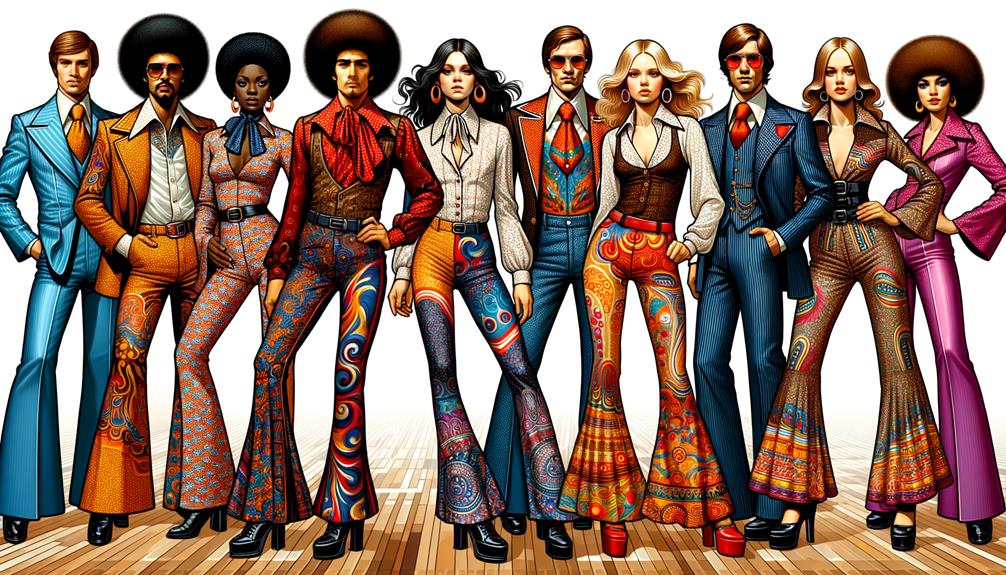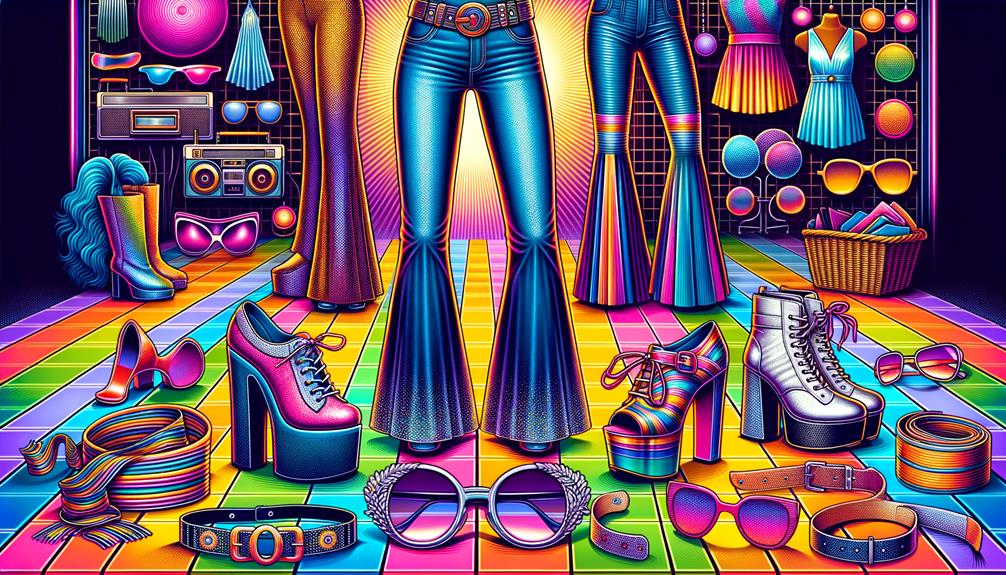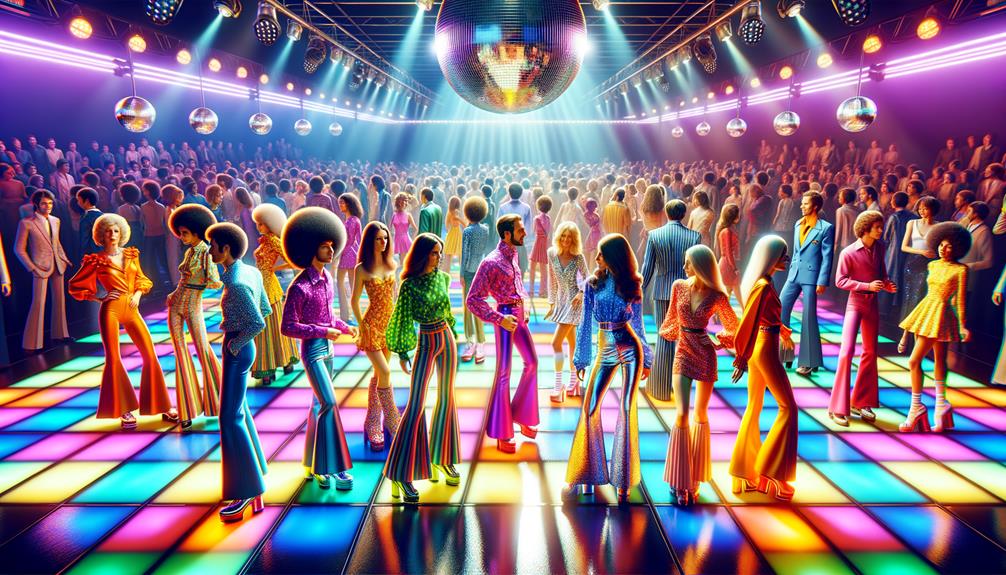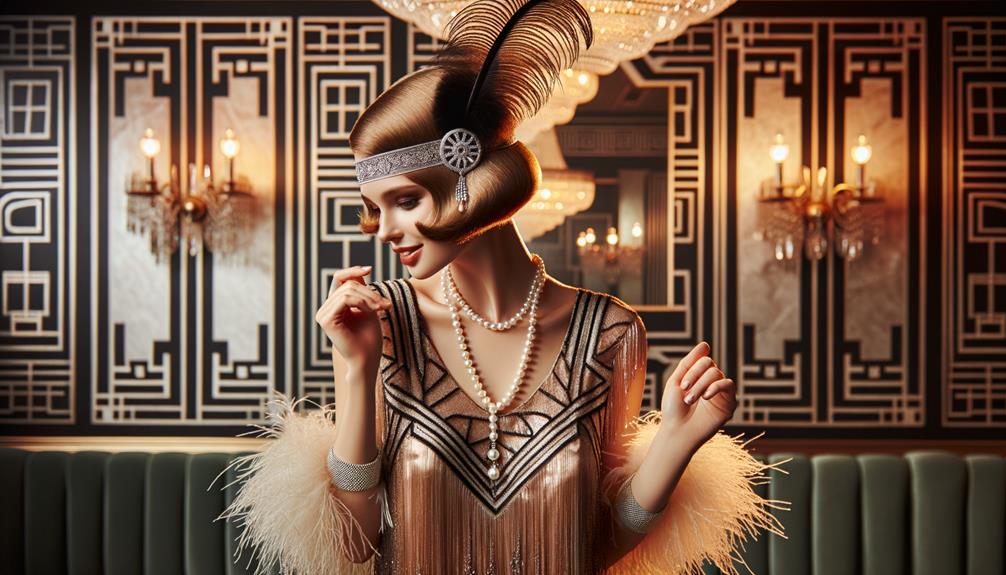The flamboyant fashion of 1970s disco culture was truly captivating. Flared pants and glitzy sequined tops were ubiquitous, shimmering with every dance move. Platform shoes added height and confidence, while fabrics like polyester and metallic lamé brought vibrant prints to life. Fashion was not just about looking stylish; it was a means of feeling the music and expressing individuality. Icons like John Travolta and designers like Yves Saint Laurent pushed the boundaries with their daring designs. Even today, the legacy of disco fashion lives on, reflecting an era of exuberance and freedom. There's much more to explore about this dazzling period.
Iconic Disco Outfits
Disco fashion was all about making a statement. Flared pants and sequined tops were integral to the dance culture of the era. The fitted disco pants flared dramatically towards the ankles, allowing dancers to move freely on the dance floor. Paired with platform shoes, this striking silhouette was both bold and functional.
Sequined tops with plunging or halter necklines were designed to catch the light, creating a dazzling effect under the disco ball. The shiny, metallic-finished fabrics like lamé gave these outfits a futuristic, space-age vibe that resonated with the innovative spirit of the time. Halter necklines were particularly flattering and allowed for unrestricted movement, essential for high-energy dance routines.
Dresses and skirts often featured high slits up the leg, adding a provocative element to the ensemble. This design choice complemented the dynamic and spirited nature of disco dancing. Overall, disco fashion was a perfect blend of style and practicality, crafted to stand out and keep up with the rhythm.
Influence of Disco Music
The disco era of the 1970s left an indelible mark on fashion. The driving beats and electric energy of disco music inspired bold, eye-catching outfits that were perfect for endless dancing. Iconic disco songs and artists didn't just create a musical soundtrack; they set the stage for the glittery, vibrant styles that defined the decade. Flared pants, sequined tops, and platform shoes became staples as people embraced the fun, expressive spirit of disco. The music's rhythmic pulse was reflected in the dynamic, functional clothing that allowed people to dance the night away in style.
Iconic Disco Fashion Trends
Disco fashion in the 1970s was all about embracing bold, glittering styles that matched the energy of the dance floor. Disco pants became a staple – tight, shiny trousers designed to reflect the light from the disco ball and create a mesmerizing effect. Paired with flared pants that had a fitted waist and dramatically flared ankles, the look was both dynamic and liberating.
On the dance floors, sequin-covered tops caught every flicker of light, dazzling the crowd with every move. These tops were more than just clothing – they were a statement, embodying the exuberant spirit of the era. Metallic fabrics like lamé added a futuristic touch, suggesting a world filled with possibilities and innovation.
Halter necklines, with their high, wrapped backs, exposed the shoulders and back, adding a sultry edge to the ensemble. Dresses and tops featuring high slits and plunging necklines accentuated dancers' movements, enhancing the sense of glamour and sex appeal. Fashion wasn't just about looking good – it was about feeling alive and vibrant, fully immersed in the disco experience.
Music's Impact on Style
The pulsating beats of disco music transformed the fashion of the 1970s. Vibrant colors, shimmering sequins, and metallic fabrics were designed to catch the light and dazzle on the dance floor, reflecting disco's hedonistic and liberating spirit. It wasn't just about looking good; it was about feeling free and alive.
Fashion designers of the era, inspired by disco anthems and icons like Donna Summer and Gloria Gaynor, created garments that emphasized freedom of motion. Flared pants swayed with every step, low-cut necklines and crop tops allowed for sensuality and comfort, and psychedelic patterns added an extra layer of visual excitement. The dance floor became a runway where everyone could shine.
Disco's sexually-charged aesthetic was a statement of liberation. The music demanded clothing that moved with the body, inviting everyone to be part of the vibrant, energetic world it created. Disco music redefined fashion, turning every outfit into a dynamic expression of individuality and joy.
Popular Fabrics and Patterns

The 1970s fashion scene was a vibrant and bold affair. Polyester took center stage, offering an affordable and low-maintenance option that perfectly complemented the era's energetic and flashy aesthetic. Meanwhile, the disco scene embraced vivid, often psychedelic prints that became synonymous with the era, turning every outfit into a statement piece. These patterns and fabrics defined the decade, capturing the spirit of the time and leaving a lasting impact on fashion history.
Bold Polyester Choices
Polyester's rise in the 1970s brought a wave of bold, vibrant patterns that defined the disco era's fashion landscape. This synthetic fabric revolutionized how we approached style, making it affordable, wrinkle-free, and perfectly suited for the dance floor. I vividly recall the era's obsession with polyester pants and hot pants, each piece exuding a sense of freedom and audacity. Fashion became more accessible, breaking down barriers and allowing everyday people to feel like rock stars. Even Mick Jagger, an icon of the time, embraced these daring looks, influencing countless fans to follow suit.
As designers pushed the boundaries, they crafted double-face knits that weren't just comfortable but also low-maintenance—a godsend for anyone living a fast-paced, disco-infused life. The decline of couture and the rise of ready-to-wear fashion can be attributed to this fabric's versatility. It allowed runway-inspired looks to be mass-produced at a fraction of the cost.
Yet, by the decade's end, some began to tire of polyester's synthetic feel. Consumers craved the touch of natural fibers once more, signaling a shift away from the ubiquitous fabric that had defined 1970s fashion.
Iconic Disco Prints
Disco fashion was a wild, psychedelic explosion of patterns and textures. These kaleidoscopic designs weren't just about looking good; they reflected the vibrant energy pulsing through the dance floors. Bold floral prints, geometric shapes, and abstract motifs added visual excitement, making every outfit a statement of individuality and exuberance.
Glam rock also influenced disco style. Shimmering fabrics like lamé created a futuristic, space-age aesthetic, perfect for catching the disco ball's light. Whether it was flared jeans or flowing jumpsuits, these materials guaranteed that everyone looked like they were ready to step into another dimension.
Stripes, both bold and subtle, adorned everything from accessories to full outfits, adding a dynamic element to the already eclectic mix. The variety of patterns and textures – from velvety smooth to sheer and lightweight – catered to the diverse needs of the dance floor, ensuring disco fever was always in full swing. In every stitch and seam, the era's innovative spirit shone through, making disco fashion a timeless icon of self-expression and creativity.
Footwear and Accessories

Footwear and accessories in the disco era not only elevated the look but also reflected the bold, eclectic spirit of the 1970s. Platform shoes were certainly the stars of the disco scene, their towering heights transforming every step into a confident and stylish statement. These shoes, with their thick soles, perfectly complemented the dramatic silhouettes that defined the decade. Clogs, on the other hand, provided a comfortable yet fashionable alternative. Often crafted from wood, they exuded a natural, earthy vibe that resonated with the free-spirited ethos of the era.
Gladiator sandals also made their mark, with their strappy, minimalist designs echoing the 1970s' love for an earthy aesthetic. These sandals embraced simplicity while making a bold statement, ideal for those who wanted to dance the night away with ease. Over-the-knee boots added a touch of drama and sensuality to disco outfits, offering both warmth and style. They were perfect for making a grand entrance and turning heads on the dance floor.
Accessories like oversized sunglasses, chunky jewelry, and wide belts further enhanced the disco look, ensuring that every outfit was as vibrant and dynamic as the music that defined the era.
Fashion Icons and Designers
While chunky jewelry and platform shoes defined the disco era's look, it was the fashion icons and designers who truly brought the vibrant, eclectic spirit of the 1970s to life. John Travolta, in his iconic white suit from 'Saturday Night Fever,' became a symbol of the era's sleek, confident style. Diane von Furstenberg's wrap dress, meanwhile, offered a perfect blend of comfort and allure, making it a staple for any disco devotee.
Yves Saint Laurent and Ossie Clark were also instrumental in shaping the fashion landscape. Saint Laurent's bold use of color and innovative designs resonated with the era's exuberance, while Clark's fluid, sensual garments captured the free-spirited vibe of the dance floor.
These trailblazers weren't just creating clothing; they were crafting a lifestyle. Each piece, whether a glittering gown or a sharp suit, was designed to move, shimmer, and captivate under the disco lights. Their work has left an indelible mark, influencing contemporary designers and ensuring the spirit of the disco era continues to inspire and innovate fashion today.
Disco Fashion's Modern Revival

Disco fashion is making a big comeback these days. It's fascinating to see how today's designers and brands are capturing the vibrant spirit of the 1970s. Fast fashion giants like Zara, ASOS, and H&M are recreating iconic looks – platform sandals, oversized sunglasses, metallic pants. It's as if we've stepped right back into the pulsing world of *Saturday Night Fever*, but with a modern twist.
High fashion is also embracing disco-inspired styles. Designers like Paco Rabanne, Dolce & Gabbana, and Versace have infused their latest collections with nods to the era – reminiscent of Bianca Jagger's glam nights at Studio 54 or David Bowie's bold, androgynous style. The use of shimmering fabrics and bold prints channels the daring spirit, much like Emilio Pucci's psychedelic patterns.
This revival isn't just about the clothes; it's a cultural phenomenon. It taps into our collective nostalgia for the energy, freedom, and sociability that defined the disco era. Modern disco fashion blends style, social, and practical elements, letting us relive the dance floor spirit that made the 1970s so memorable. For those seeking something new, disco fashion offers a joyful, liberating throwback that feels surprisingly fresh.
Frequently Asked Questions
What Was Disco Fashion Like in the 1970s?
Disco fashion in the 1970s was all about making a bold statement. You'd see flared pants, shimmering sequins, and vibrant colors. The daring designs and glittery outfits broke away from traditional norms, creating an energetic, attention-grabbing style that captivated the era.
How to Dress for a 70's Disco Party?
To stand out at a 70's disco party, wear flared pants, a sparkly top, and metallic fabric. Add some height with platform shoes, and complete the look with bold patterns or asymmetrical designs. This ensemble will ensure you're the life of the party and leave a lasting impression on your fellow disco enthusiasts.
What Was the 1970S Fashion Era Called?
The 1970s fashion era was known as the 'Disco Era.' This period was marked by bold self-expression, with vibrant and eye-catching styles dominating the fashion landscape. It was a time when fashion broke away from traditional gender norms, celebrating freedom and individuality.
What Defines Disco Fashion?
Disco fashion is all about bold, vibrant colors, shimmering fabrics, and flared silhouettes. It embraces a sensual, daring style with revealing outfits and avant-garde elements like asymmetry and shoulder pads, creating a striking, gender-inclusive look perfect for energetic dance floors.
Conclusion
Looking back, the disco era was certainly a sight to behold. The vibrant outfits, pulsating music, and eclectic fabrics left an indelible mark on fashion. Even today, we see echoes of those shimmering styles in modern trends. It's fascinating how fashion often comes full circle, with the past inspiring the future. The era's boldness and creativity continue to captivate, proving that sometimes, history isn't just a distant memory, but a stepping stone to new styles.



